
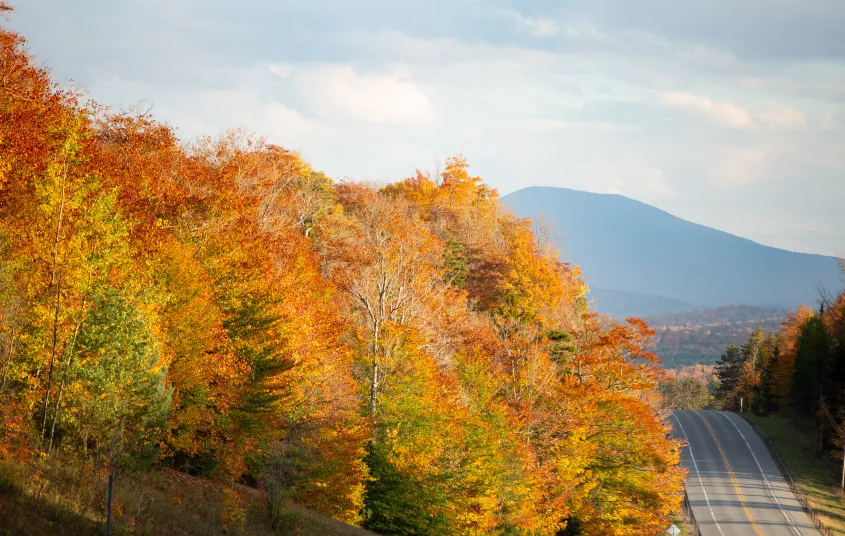
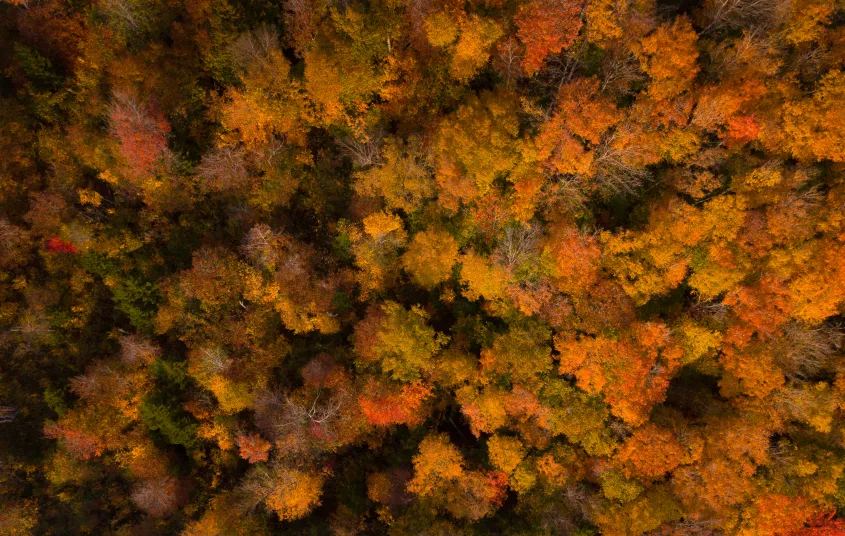
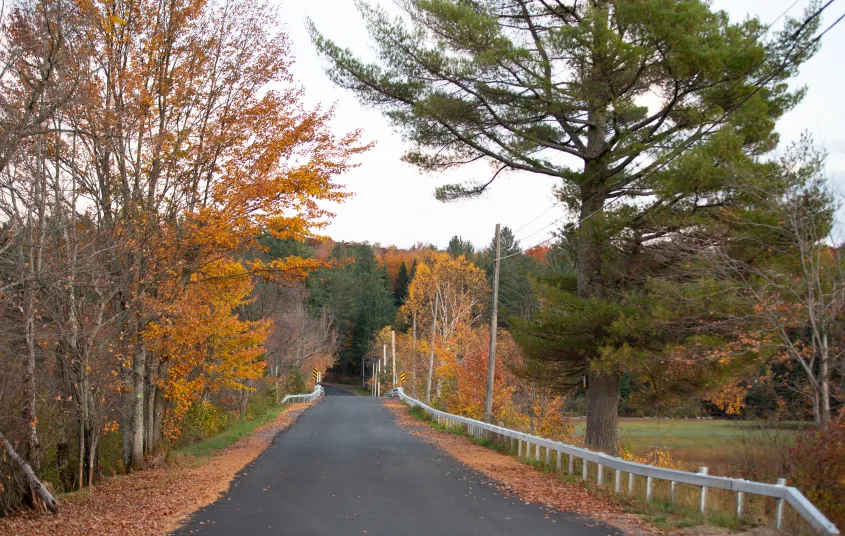
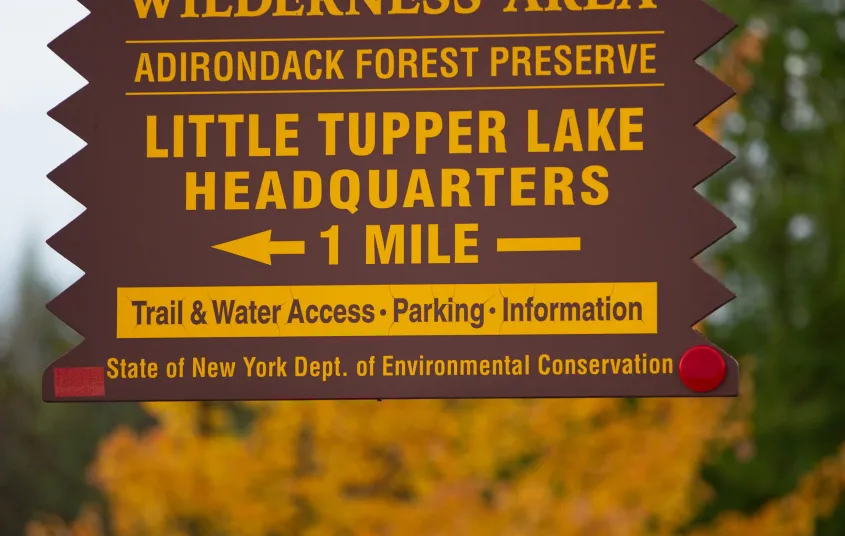
The William C. Whitney Wilderness Area is a paddlers paradise. But that said, there are hiking opportunities here for hikers, birders, campers, fishermen and women, and even some hiking for paddlers.
How to get there
The Little Tupper (Whitney) Headquarters parking area has parking, a hand launch, and accessible restrooms.
From the downtown of Tupper Lake, head southwest on Park Street toward High Street. You will pass by Stewart's Shops on the left. At the 0.2 mile point, turn left onto NY-30 S/Wawbeek Ave. Follow NY-30 S for 11.2 miles. Turn right onto Circle Road for 3.0 miles. Continue straight onto Sabattis Rd for 1.3 miles, where there is a left turn for 0.2 miles. Then turn right onto William C. Whitney Headquarters Road, keep to the left, and destination will be on the left some 800 feet later.
Hiking
This is an easy Adirondack trail system which totals 13.5 miles. The William C. Whitney and Round Lake Wildernesses are both in this general area, separated only by Sabattis Circle Road. These two Wilderness Areas are flatter than much of the Adirondacks, with low rolling hills and abundant bodies of water. Many of the routes were originally old logging roads, so the trails are broad and easy to follow. Burn Road is the main access trail to viewpoints and campsites along the north shore of Little Tupper Lake.
The Whitney Wilderness has two large lakes which can be reached via the trails. Little Tupper Lake has two trails which border the north and south shores. Stony Pond Trail and Lilypad Pond Trail. Rock Pond can be reached via a connector with Lilypad Pond Trail.
The Round Lake Wilderness is dominated by Round Lake, which has water access from Circle Road, but no trails.
Paddling
The Whitney Wilderness is a paddler's paradise, with plentiful carries from the trailheads and many connected water bodies. Motorized boats are not allowed, and there are no hard surface launches.
There are five carries to water bodies. The longest is the 1.8 miles between Rock Pond and Hardigan Pond. There's a 0.5 mile new carry between Hardigan Pond and Salmon Lake Outlet, which has been rerouted around wetlands. Find the take-out for the carry east of where Hardigan Pond narrows, on the south side.
There's a 0.5 mile carry between Little Salmon Lake and Lily Pad Pond, and then another 0.8 mile carry to reach Shingle Shanty Brook. The canoe carries from Little Tupper to Shingle Shanty Brook are signed and marked. Other carries to other ponds in the interior are unimproved paths.
*Please note Little Tupper Lake is shallow and placed where wind can create large waves. Be careful during rough weather, and hug the shoreline while paddling.
Camping
These two Wilderness Areas are ideal for a paddling and camping excursion. These sites are most easily reached by water, and many can only be reached by paddling.
Camping is only allowed at 60 designated primitive tent sites in the Whitney Wilderness. There are 11 designated primitive tent sites in the Round Lake Wilderness, and primitive camping is allowed, with restrictions. Follow the rules for Adirondack Primitive Camping.
There's also a lean-to on the western shore of Lake Lila.
Fishing
Lake Lila contains smallmouth bass at the northeast end, which has abundant rocky habitat. Look for lake trout in the deep water west of Buck and Spruce Islands.
Fish Little Tupper Lake, Round Lake, and Rock Pond for a unique "heritage" strain of brook trout, known as the Little Tupper strain. Only artificial lures. All brook trout should be immediately returned to the water alive.
Birding
This area is an ecological transition zone between the temperate deciduous forest and the boreal forest, with almost one third being wetlands. Loons and Hooded Mergansers are commonly seen and heard on these waters. Bald Eagles and Osprey are often seen soaring over them. The Audubon Society has designated the William C. Whitney Wilderness as an Important Bird Area.
Look for American Bittern, American Black Duck, Northern Goshawk, Canada Warbler, Rusty Blackbird, Pied-billed Grebe, Olive-sided Flycatcher, and Palm Warblers.
Cross-country skiing and snowshoeing
Cross-country skiing and snowshoeing are permitted on all hiking trails, with easy terrain and former road status making them excellent trails. In winter, the Lake Lila Access Road is gated off and closed to public traffic, making this a popular backcountry ski route. Be aware that private landowners might use it occasionally.
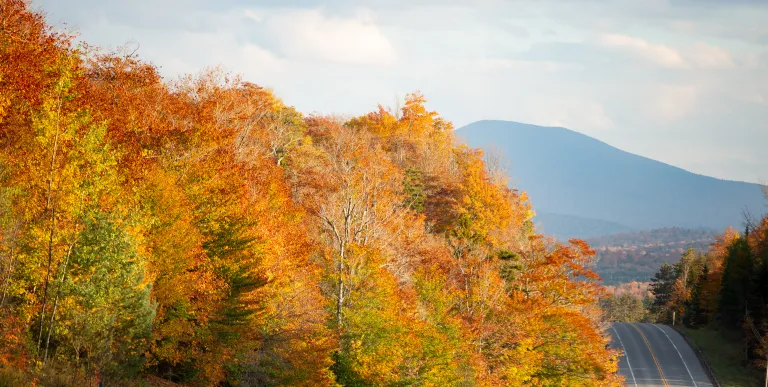
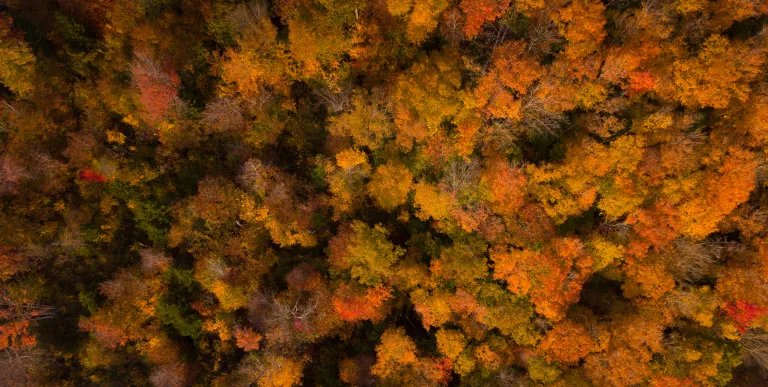
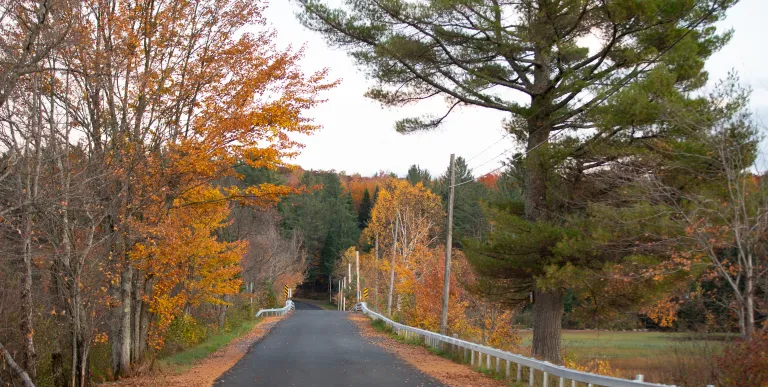
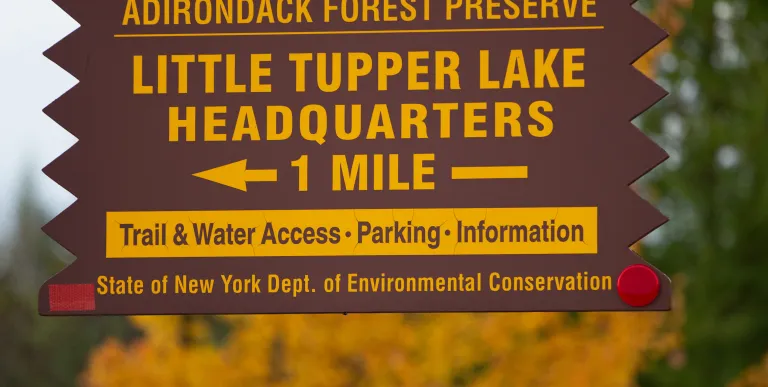
Packages and Promotions
Valid
Valid Jun. 15 - Oct. 16
weekly on Tuesday until October 21, 2025
Taco Tuesday at RRB
The Marketplace - Food Truck
Free RRB Margarita with Your Marketplace Food Truck Tacos
Join The Marketplace Food Truck and Raquette River Brewing for the ultimate Taco
Valid
Valid Jun. 13 - Oct. 15
weekly on Monday until October 14, 2025
Mexican Mondays
The Clubhouse at TLGC
Head to The Clubhouse for bold flavors, rotating Mexican dishes, and $6 margaritas every Monday.
Valid Jun. 30 - Jun. 30
Valid Jun. 30 - Jun. 30
Tri-State Resident discount at Trailhead
Residents of New York, New Jersey, and Connecticut are invited to enjoy savings of up to 15% on your next Adiron
Valid Sep. 26
Valid Sep. 24 - Sep. 26
Free Pool All Day at P-2's Irish Pub
P-2's Irish Pub
Free Pool at P-2's Irish Pub
Valid
Valid Dec. 8 - May. 21
weekly on Thursday until May 28, 2026
Thursday Meal Deal
Raquette River Brewing
Thursday Deal at Raquette River Brewing! Every Thursday, head to Raquette River Brewing for a deal you won't want to miss. Spend $14 at LJ Food Truck and/or Fusion Street and receive a FREE drink token for your next round at the brewery. This special...
Valid Jul. 13 - Jul. 13
Valid Jul. 13 - Jul. 13
3rd Night Free at Trailhead
Book two consecutive nights at our regular Best Available Rate and get your 3rd night on us. Staying longer than three nights? 3rd Night Free! is available for EVERY 3rd night.
Valid Nov. 28
Valid Nov. 19 - Nov. 28
Small Business Saturday at Cabin Fever Floral
Cabin Fever Floral & Gifts
Cabin Fever is dicounting everything in the store 20%, sample our ADK Chocolates and enter to win a Christmas arrangement.
Valid Nov. 30
Valid Nov. 18 - Nov. 30
Raquette River Brewing - Cyber Monday
Raquette River Brewing
Cyber Monday Brews & Adirondack Views (From Your Couch!)
Get cozy this Cyber Monday and support local businesses from the comfort of y
Valid Mar. 31 - Oct. 30
Valid Apr. 14 - Oct. 30
Golf & Stay
Voco Saranac Lake
Tee off at one of the Adirondacks' historic golf courses, surrounded by breathtaking mountain views.
Valid Nov. 13
Valid
10 Year Anniversary at Spruce & Hemlock
Spruce & Hemlock
Our 10 year Anniversary is on November 15th!
Valid Sep. 5 - Sep. 24
Valid Sep. 7 - Sep. 23
Fall Foliage Special
Northwood Cabins
Three nights for the price of TWO!
Valid
Valid Jun. 15 - Oct. 15
weekly on Wednesday until October 16, 2025
Wing Wednesdays: Full Flavor, Half Price!
The Clubhouse at TLGC
Dig in and save big! Join us every Wednesday at The Clubhouse at Tupper Lake Golf Club for Wing Night Wednesdays, featuring 50% off chicken wings from 4:00 to 8:30 PM.
Valid Mar. 31 - Oct. 30
Valid Apr. 14 - Oct. 30
Fish & Stay
Voco Saranac Lake
Enjoy a 2-hour fishing session on Lake Flower for two, guided by expert anglers.
Valid Nov. 28
Valid Nov. 25 - Nov. 28
Small Business Saturday at Ray's Discount Liquor
10% off on these specific liquor and wine.
Berlinger Founders Cab 1.5L and 75
All Boda Box 3 Liter
Machio Prosecco
Valid Nov. 27 - Nov. 29
Valid Nov. 13 - Nov. 29
Three-Day Holiday Sale at Spruce & Hemlock
Spruce & Hemlock
Holiday Sale at Spruce & Hemlock!
Valid Jul. 31 - Aug. 2
Valid Mar. 31 - May. 30
BikeADK Loves Canada - Weekender
Canadian Residents can use the code “BikeADKLovesCanada" will receive 15% off their registration!
Valid
Valid Nov. 25 - May. 28
weekly on Tuesday until November 25, 2026
PorkBusters BBQ Taco Tuesdays!
Pork Busters - Food Truck
Who doesn’t love Taco Tuesday?
Valid
Valid Jun. 15 - Aug. 30
weekly on Friday until August 31, 2025
2 for 1 Happy Hour Cosmos and Friday Fish Fry
P-2's Irish Pub
Start your weekend right with 2-for-1 Cosmopolitans for just $8 every Friday at P-2’s Irish Pub—plus don’t miss our Friday Fish Fry!
Valid Nov. 27 - Nov. 28
Valid
Small Business Saturday
Tupper Arts
Black Friday and Small Business Saturday are headed to Tupper Arts on November 28 and November 29, 2025.
Valid
Valid Dec. 19 - Jan. 30
weekly on Friday until January 31, 2026
Buns & Brews Special
P-2's Irish Pub
Every Friday, P-2's Irish Pub on Main Street in Tupper Lake offers our delicious Buns & Brew Special.
Valid
Valid Jun. 15 - Oct. 15
weekly on Friday until October 17, 2025
$20 Fish Fry Friday
The Clubhouse at TLGC
Get Hooked on Fish Fry Friday at The Clubhouse
Join us every Friday at The Clubhouse at TLGC for a delicious Fish Fry Friday tradition.
Valid Nov. 27
Valid Nov. 18 - Nov. 27
Raquette River Brewing - Black Friday!
Raquette River Brewing
Score Big on Black Friday at Raquette River Brewing!
Looking for the perfect Adirondack souvenir or a gift for the craft beer lover in you
Valid Mar. 31 - Jan. 29
Valid Jan. 20 - Jan. 20
Pet Getaway
Voco Saranac Lake
Your dog deserves an Adirondack getaway too. Book our pet friendly hotel near Lake Placid welcomes every member of your crew. Book our Pet Package and enjoy a dog friendly room with pet fees included.
Valid Jun. 30 - Sep. 29
Valid Jun. 30 - Sep. 29
weekly on Monday, Tuesday, Wednesday, Thursday, Friday, Saturday and Sunday until September 30, 2025
Timberjaxx Pass Loyalty Card
Timberjaxx Pass
Get the Timberjaxx Loyalty Card and earn a free game after five rounds. Fun, treats, and no card to carry.
Valid Nov. 28
Valid Nov. 18 - Nov. 28
Raquette River Brewing - Small Business Saturday
Raquette River Brewing
Celebrate Small Business Saturday with Raquette River Brewing!
Skip the big box stores and connect with the heart of Tupper Lake this Smal
Valid
Valid Sep. 6 - Feb. 7
weekly on Sunday until February 8, 2026
Sunday GameDay Specials
Foul Line Sports Bar at Lakeview Lanes
Lakeview Lanes is Tupper Lake’s go-to destination for fun—whether you’re here for bowling, arcade games, or catchin
Valid Aug. 7 - Aug. 14
Valid Aug. 7 - Aug. 14
Spruce & Hemlock: End of Season Clothing Sale
Spruce & Hemlock
Join us for our End of Summer Sale with prices starting at just $10.00!
Valid Nov. 25
Valid Nov. 24 - Nov. 26
Half Price Bowling & Shoes
Lakeview Lanes
Thanksgiving Eve Special at Lakeview Lanes
Kick off the holiday weekend wit
Valid Mar. 31 - Oct. 30
Valid Apr. 14 - Oct. 30
Bike & Stay
Voco Saranac Lake
Explore the beauty of Saranac Lake and the newly developed Adirondack Rail Trail.
Valid Mar. 31 - Oct. 30
Valid Apr. 14 - Oct. 30
Paddle & Stay
Voco Saranac Lake
Escape to the serene beauty of the Adirondacks and immerse yourself in nature as you paddle the tranquil waters of Lake Flower in a kayak, canoe, or SUP
Valid Nov. 27 - Nov. 28
Valid Nov. 24 - Nov. 28
Small Business Saturday
The Adirondack Store & Gallery
Adirondack Store and Gallery will be starting the Christmas shopping season off on Black Friday and continue through Small Business Saturday.
Valid Jul. 3 - Aug. 30
Valid Jul. 1 - Aug. 30
Classic Films, Summer Vibes – Only $5
Adirondack State Theater
$5 classics. Cool theater. Daily at 4 PM. All summer long, the Adirondack State Theater brings timeless films to the big screen for just five bucks.
Valid
Valid Sep. 26 - Oct. 28
weekly on Wednesday until October 29, 2025
Witchy Wednesdays Cocktail Features
The Woodshed on Park
Witchy Wednesdays—a month-long celebration of spooky season with enchanting cocktails crafted to thrill your taste buds.
Valid Dec. 4 - Dec. 6
Valid Nov. 19 - Dec. 6
Holiday Stroll Cocktail Features
The Woodshed on Park
Get into the holiday spirit during the Holiday Stroll with seasonal cocktail features crafted just for the weekend.
Valid
Valid Jul. 22 - Aug. 30
weekly on Monday, Tuesday, Wednesday, Thursday and Friday until August 30, 2025
Caribbean Kitchen Takeout
Faust Motel
Caribbean Kitchen Pop-Up Takeout Returns
We’re excited to announce the retu
Valid Nov. 30 - Jan. 27
Valid Nov. 19 - Jan. 27
Tupper Motel December / January Room Special
Escape to Tupper Lake This Winter!
Cozy Rooms, Unbeatable Rates at the Tupper Motel
Looking for a winter getaway that combines co
Valid Jan. 20 - Jan. 20
Valid Jan. 20 - Jan. 20
Stay and Dine
Voco Saranac Lake
Receive a 50 dollar credit per stay to use in our Lakeside Drift. Enjoy an exceptional dining experience with unparalleled views great food and craft beers in a friendly and relaxed environment.
Valid
Valid Dec. 18 - Feb. 27
weekly on Wednesday until February 28, 2026
Wine Down Wednesday
P-2's Irish Pub
Unwind midweek with 2-for-1 house wines every Wednesday during happy hour from 4-6 p.m. at P-2’s Irish Pub on Main Street in Tupper Lake.
Valid Nov. 27 - Nov. 29
Valid
Holiday Sale at Spruce & Hemlock!
Unwrap Holiday Cheer at Spruce & Hemlock!
Discover the perfect gifts for everyone on your list at Spruce & Hemlock's Holiday Sale!
Valid Jun. 30 - Jun. 30
Valid Jul. 13 - Jun. 30
Book Now, Adventure Later with Trailhead
Book two or more consecutive nights 45+ days in advance and receive up to 20% off, with the flexibility to adjus